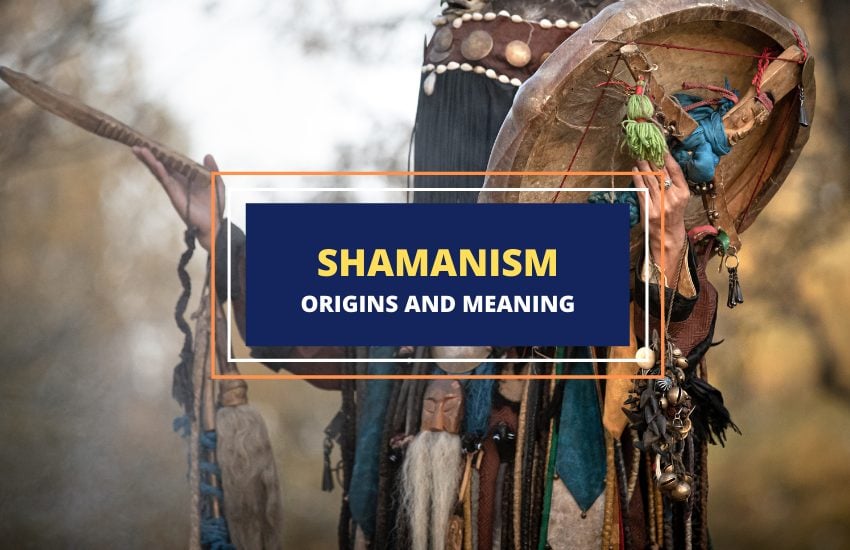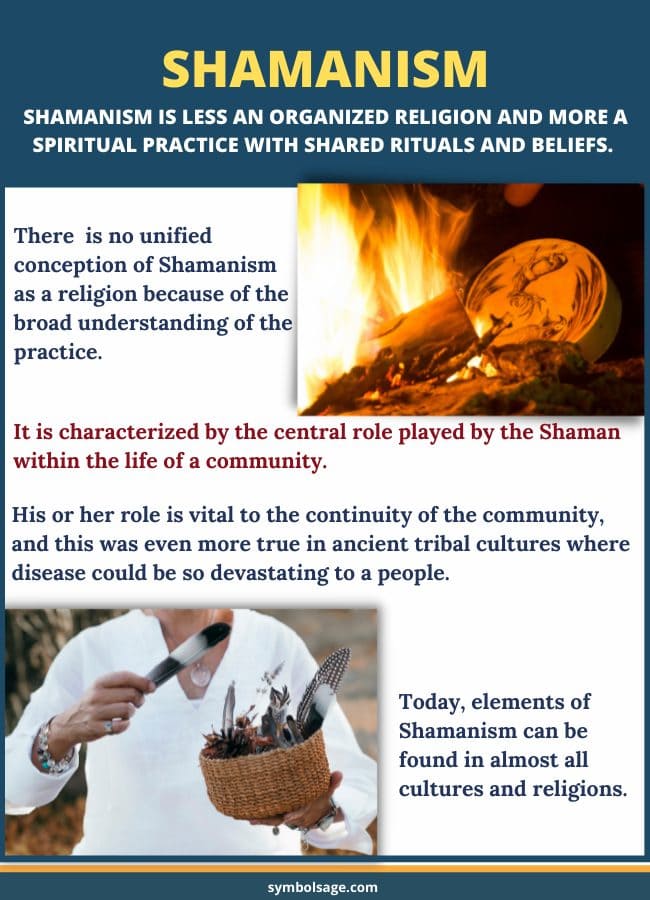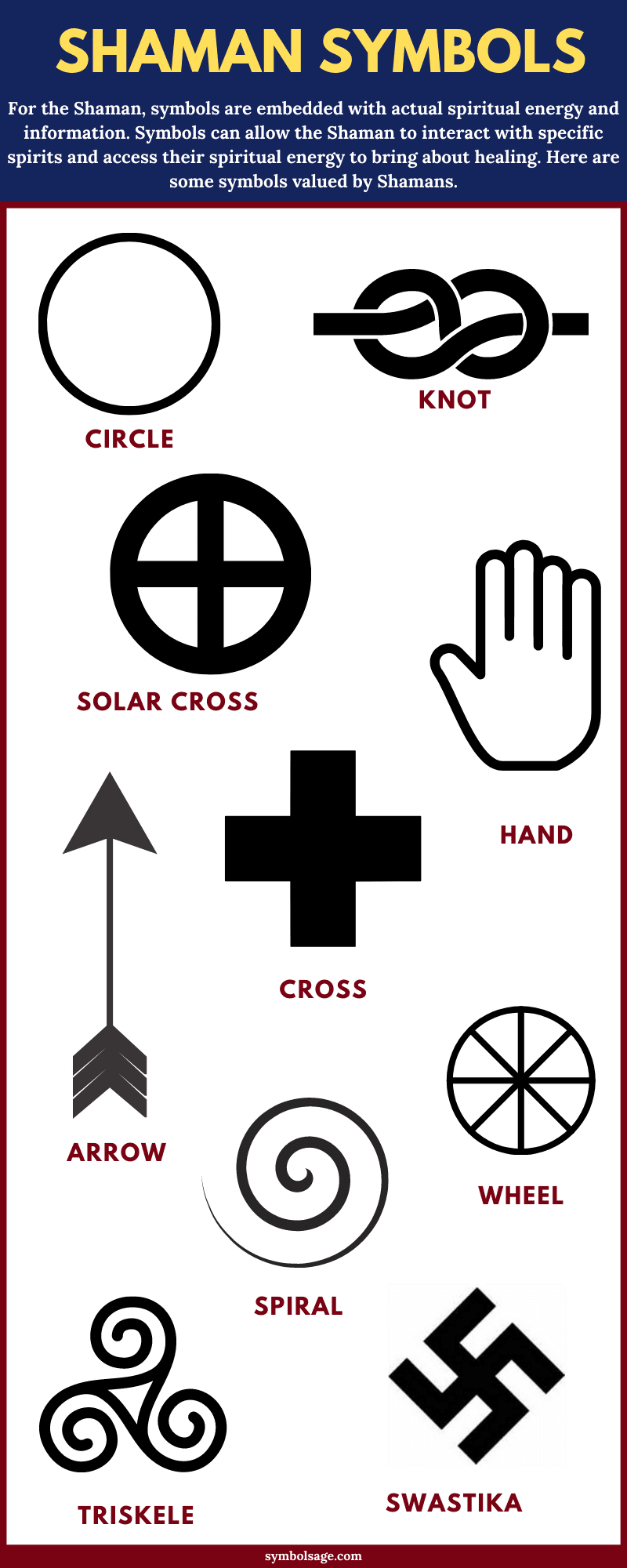
Table of Contents
Shamanism is less an organized religion and more a spiritual practice with shared rituals and beliefs. The practice of Shamanism centers around a practitioner, or Shaman, with unique access to the unseen world of spirits.
Shamans employ ritual practices in order to communicate with spirits by entering into a trance-like state. Because Shamanism is not organized into a religion as some of the other major belief systems, it is practiced by people of various cultures, locations, and periods.

Origin of the Term Shamanism
The words Shaman and Shamanism are widely believed to have originated in the Tungusic language family of Eastern Siberia and Manchuria. The Tungusic word šamán means “one who knows”.
The term first appears in a European context in the journals and writings of Russians who interacted with the Siberian people. The Dutch statesman and administrator of the Dutch East India Company, Nicolaes Witsen, is responsible for popularizing the term in Western Europe after traveling among the Tungusic tribes.
Alternative possibilities for the origin of the term include the Sanskrit word śramana. This word refers to traveling monastic figures, “wanderers,” “seekers,” and “ascetics”. The word may have traveled to central Asia and become the ultimate source of the term.
Because of the term’s connection with Western colonization efforts of the 16th century, it has come under some scrutiny. In recent years, the growth of Shamanism among white European peoples has also leveled charges of cultural appropriation, as they have little to no cultural connection to the practices.
Basic Beliefs and Practices of Shamanism
The term Shamanism is used by anthropologists, archaeologists, and historians to refer to a set of beliefs and practices found among indigenous tribes ranging from Siberia to North America to Australia and beyond.
At the core of shamanic belief is the Shaman, who possesses a unique ability to access the unseen, spiritual world. A Shaman accesses this world by entering a trance to communicate with benevolent and malevolent spirits in an attempt to manipulate spiritual energies affecting people in the physical world.
According to this perspective, sickness is a physical manifestation of the activity of evil spirits. Thus, the Shaman plays a critical role in the life of a community because of their healing ability.
The practice of Shamanism makes use of various tools to access and commune with the spirit world. One of the primary tools used by a Shaman to enter into trances is entheogens.
Meaning “the divine within,” an entheogen is a substance of plant origin used to achieve an altered state of consciousness for spiritual purposes. In other words, plants with hallucinogenic properties are made into ingestible forms. Examples include peyote, mushrooms, cannabis, and ayahuasca.
Music and song also play a significant role in the Shaman achieving a trance state. The drum is the primary instrument used in songs. It is often accompanied by ecstatic dancing to the rhythmic repetition of the beat.
Other practices of the Shaman include vision quests, fasting, and sweat lodges. Finally, one of the primary tools for the Shaman to access and manipulate spirits and spiritual energies are Shamanic symbols.
Shaman Symbols and Their and Meanings

For the Shaman, symbols are embedded, not just with meaning, as in some other religious traditions, but with actual spiritual energy and information. When used correctly, certain symbols can allow the Shaman to interact with specific spirits and access their spiritual energy to bring about healing.
While there is a wide variety of symbols used by Shamans, some consistent images appear across cultures and distances. These include circles, spirals, crosses, and groups of three. These images can all be found in Native American, Druidic, Middle Eastern, and other traditions. So, what are some of the standard symbols used by Shamans and their meanings?
- Arrow – protection, defense, direction, movement, power
- Circle – equality, family, closeness, protection
- Cross – division of the cosmos (Native American), cardinal directions
- Cross in a Circle – “solar cross”, sun and fire (Native American)
- Hand – human life, power, strength
- Knot – in various forms, wisdom, eternal life, eternity,
- Spiral – journey
- Swastika – eternity (Buddhist), sun (Native American)
- Triskele – three stages of life, three elements of earth, sea, and sky (Celtic)
- Wheel – life, life cycle, life stages
One interesting note on the use of symbols is the idea that symbols can become confused or conflicted. The most famous of these conflicted symbols is the swastika.
What was once a Buddhist symbol for the eternal was coopted by the German Nazi Party, referring to it as the “broken cross,” a symbol of Arian purity. Thus, this once common religious symbol became confused with evil ideologies and is almost nonexistent today.
Some see the Christian cross as a conflicted symbol because it is meant to celebrate Jesus by remembering his execution. However, the use of the cross by Christians is intended to remind followers of his willingness to sacrifice himself for others. This, it would seem, is a positive use of the symbol.
The manipulation of written words can also develop into new symbols. For example, Shamans may take a meaningful word, add lines or other images, and connect letters or change their orientation in order to fill the new symbol with meaning.
This then becomes a new symbol that can be used on behalf of a specific person in need of healing or to connect with a particular spirit.
FAQs About Shamans
Shamans play an important role in their community, functioning as healers and diviners.
Shamanism is practiced by people of various cultures, locations, and periods. The practices continue today in various parts of the world.
Yes, female Shamans are also called Shamanka. This is made by adding the Russian suffix -ka, which makes a noun feminine.
There are resources, like the Foundation for Shamanic Studies, that assist those interested in becoming Shamans.
Yes, there are many modern Shamans.
It’s difficult to find scientific evidence that supports Shamanic practices, and there aren’t any regulating bodies that certifies or registers Shamans.
Final Thoughts
The controversy surrounding the spread of what is sometimes referred to as Neo-Shamanism is the practice of these rituals by people disconnected from traditions and lineage. Traditionally shamans underwent a period of initiation and learning, including rites of passage, which incorporated them into the tradition of serving their community as a Shaman. Whether or not people outside of these ethnic identities and traditions can and should be practicing Shamanism is a source of much debate.
There really is no unified conception of Shamanism as a religion because of the broad understanding of the practice. It is characterized by the central role played by the Shaman within the life of a community. His or her role is vital to the continuity of the community, and this was even more true in ancient tribal cultures where disease could be so devastating to a people. Today, elements of Shamanism can be found in almost all cultures and religions.








